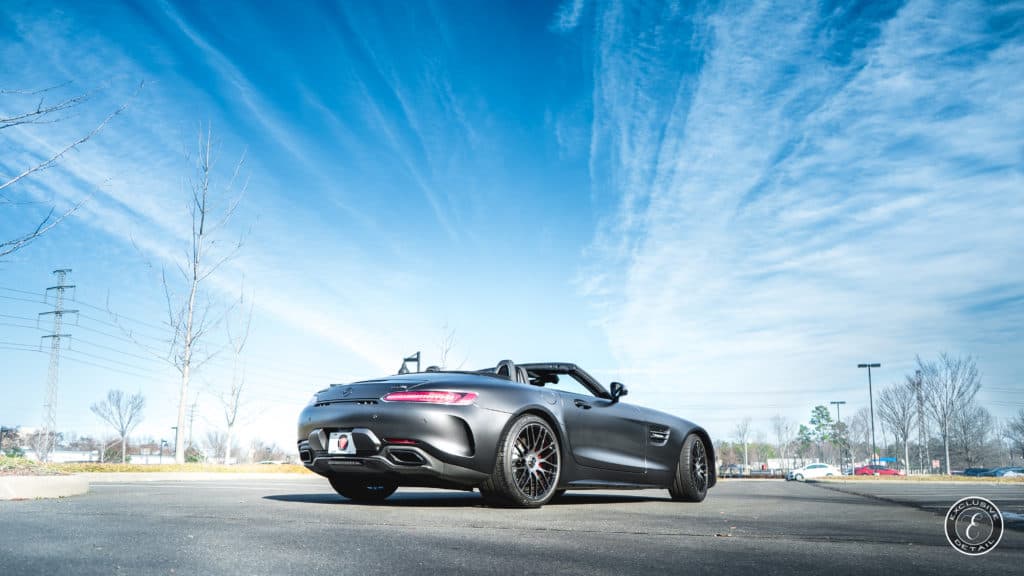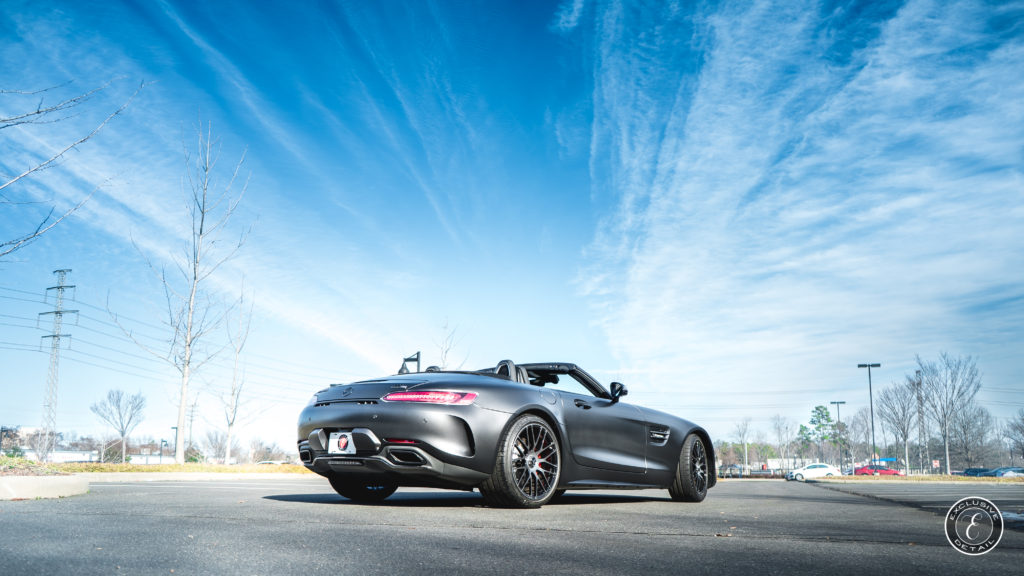Automotive Paint Protection Film (PPF) keeps your car looking better for longer.
That’s the biggest and most important takeaway when it comes to PPF. And if that’s all you want or need to know about it, please feel free to explore other areas of our website right now. However, since almost all of our customers at Exclusive Paint Protection Charlotte – PPF, Ceramic Coating & Window Tinting are car enthusiasts (to put it mildly), we want to provide some background about PPF that will put its role, history and importance into context.
The Basics
As we’ve touched on elsewhere on our site, Paint Protection Film is the most comprehensive form of defense you can establish between your vehicle and all the things that can damage its appearance. Because of PPF’s high-impact resistance, its application will protect your paint from chips and scratches caused by rocks and road debris. The urethane film is resistant to corrosion and acidic contaminants, meaning that it creates a line of defense from chemical stains and etching caused by bird droppings, bug splatter, and mineral deposits and acid rain. It does not oxidize with exposure to the sun, and will guard your paint from fading caused by UV rays. The top layer of a quality film is made up of elastomeric polymers that return to their natural shape after being stretched or disfigured, giving the film a “self-healing” property. That means when light scratches are inflicted in the film, it absorbs the damage and returns to the texture and properties it had before the incident.
For all of Paint Protection Film’s many benefits, it is not a cure-all when it comes to keeping shiny cars shiny. There are rocks that can puncture Paint Protection Film. If bird droppings or bug splatter are allowed to sit on film for a long period of time, it can cause damage. After applying Paint Protection Film, you still have to wash your car. So PPF isn’t perfect. But it is the best way to keep your fine automobile looking its best for an extended period of time.
The History Behind PPF
Automotive Paint Protection Film is a transparent, urethane material. Urethane technology was developed during the Vietnam War, when US helicopters were crashing due to damaged rotor blades. The military worked with the company 3M to develop a technology that would be lightweight, but resilient, and could be replaced at a fraction of the cost of replacing an entire rotor blade (or a crashed helicopter for that matter). In the 1970s, the military expanded its use of urethane films to the noses of fighter jets.
In the 1980s, NASCAR saw how urethane technology could protect the front half of their race cars – you know, the part with all of the advertiser’s logos. It turns out that advertisers weren’t too keen on having their logos damaged by flying debris.
During the 1990s, urethane films became available to the general public for automotive protection. Since then, the technology has been continually refined and improved, and has been enthusiastically welcomed across the automotive industry. Today Paint Protection Films are OEM approved by virtually all automotive manufacturers.
The Technology Behind PPF
If you’re going to wrap something around your fine new vehicle, it makes sense to know what it is. As we mentioned previously, the key ingredient in PPF is urethane, a powerful and versatile polymer made from carbamate links. As a compound, it is lightweight and transparent, like plastic. Unlike plastic it is not brittle or susceptible to tears and cracks. Urethane has a high resistance to impact, abrasion and corrosion. It is also incredibly flexible, and can return to its natural shape after being stretched or disfigured.
Given the polymer’s diverse and advantageous attributes, urethane has a wide variety of industrial and practical applications. For example, urethane is used in the household caulk that lines your bathroom tiles, because it seals out moisture and prevents the growth of mildew or fungus. It can also be found in the coatings of boats and underwater cables, as well as in various sporting equipment, from football pads to surfboard fins.
A quality Paint Protection Film is made up of multiple layers. In addition to the central layer that’s made up of urethane (or polyurethane), there is a layer of clear coat that’s made up of elastomeric polymers. As we mentioned above, this is the part that enables a good film to heal itself from small scratches. But it does much more. The clear coat on a good film will have a low surface energy, which prevents organic compounds, like bugs or bird droppings, from bonding with the film.
The bottom is lined with an acrylic adhesive that is designed to be flexible, so that it can be stretched and wrapped around every contour of your vehicle. It’s also durable, so the film will not detach over time. Last but certainly not least, it is invisible, so it won’t affect the look of your paint.
Don’t Believe Everything You Read
If you have done Internet research about PPF, you may have come across various accounts from people who have experienced defects after a certain amount of time. In particular, from people who have purchased an after-market PPF and have noted yellowing, blistering and peeling. For you to make an informed decision, it is important to know what’s behind each of these PPF degenerations and what you will need to do to avoid them.
YELLOWING
An early complaint against Paint Protection Film was that after time it began turning yellow. This complaint was particularly prevalent when PPF first started being applied to consumer automobiles many years ago. After researching the matter, film manufacturing companies found that the yellowing effect came from the adhesive that was used to bind a film to the body of a car. UV exposure was oxidizing the adhesive, which lead to discoloration. Upon this discovery, companies began researching alternative adhesives, and began using the acrylic adhesives that are found on most PPFs today. This newly developed adhesive is UV resistant, and will not oxidize or discolor. This effectively resolved the discoloration concern for Paint Protection Film. Today, if you put a sub-standard film on your car, it may use an inferior adhesive and lead to discoloration. But all quality professional film manufacturers, like XPEL and SunTek, use a more recently developed adhesive that does not discolor due to UV exposure.
BLISTERING
PPF is said to “blister” when small air bubbles are found underneath the film. The blistering effect has everything to do with the quality of application. Typically, an air bubble occurs because a contaminant is trapped under the film, creating separation between the body of the vehicle and the PPF. Over time, this can lead to growing bubbles under the film. A proper application process includes hairsplitting attention to the vehicle’s surface before any film touches paint. This includes washing, claying, and polishing. Moreover, a professional application center creates a controlled environment where the air can be filtered to remove contaminants that could potentially get trapped underneath the film. Thus, a sub-par film and unprofessional application can lead to blistering. When a quality film is properly applied by an experienced technician, the risk of blistering is minimal.
PEELING
Peeling is when the edges of a PPF begin to peel away from the vehicle’s paint. It can result from a sub-standard film or unprofessional application, but it is often the result of improper care. Specifically, if you are using a pressure washer to clean a car with Paint Protection Film, it is important to stay at least 12 inches away from the film, and particularly from any exposed edges. If a pressure washer is directed at the edge of a film, it can begin lifting it, which leads to peeling.
In summary, the complaints against Paint Protection Film do arise from real-world situations. However, as we have outlined, these situations have specific causes that can be averted. If you purchase a high quality film, have it installed at a reputable shop, and properly care for your protected vehicle, then the risk of defects like yellowing, blistering or peeling are next to none. And if any of those things do occur, you will be covered by a 10-year manufacturer’s warranty.
Drive Protected
At this point, you probably know as much as any consumer would want or need to about PPF. Let’s review: when it comes to keeping your new vehicle looking new, Paint Protection Film is the most comprehensive and longest-lasting solution. Urethane, which is the primary material used to make PPF has a long and varied history of protective applications. And lastly, while yellowing, blistering and peeling are real degenerative issues associated with PPF, if you select a premium PPF brand and an experienced and reputable installer, the chances of experiencing these conditions are minimal.
You have now been formally introduced to Paint Protection Film. We hope this is just the beginning of a long and rewarding relationship! If you have additional questions, or if you want to schedule an appointment, please click below.





